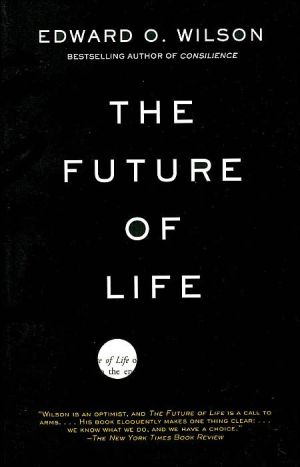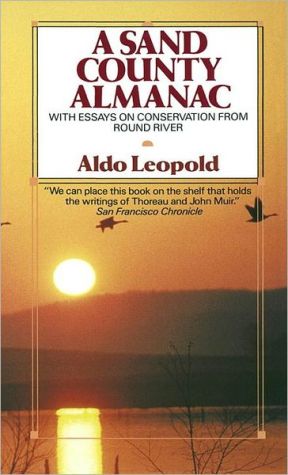The Future of Life
From one of the world’s most influential scientists (and two-time Pulitzer Prize–winning author) comes his most timely and important book yet: an impassioned call for quick and decisive action to save Earth’s biological heritage, and a plan to achieve that rescue.\ Today we understand that our world is infinitely richer than was ever previously guessed. Yet it is so ravaged by human activity that half its species could be gone by the end of the present century. These two contrasting...
Search in google:
From one of the world's most influential scientists (and two-time Pulitzer Prize winning author) comes his most timely and important book yet: an impassioned call for quick and decisive action to save Earth's biological heritage, and a plan to achieve that rescue. Eric Wargo - Book Magazine There are a staggering number of species on Earth, and half may go extinct by century's end. Pulitzer Prize-winning biologist Wilson is one of our most eloquent spokesmen for the necessity of conserving Earth's dwindling biological heritage, for reasons as much practical as sentimental and moral. Letting species disappear while hoping someday to re-create them in the test tube, he says, is tantamount to destroying great masterpieces, knowing we have copies. We must not only celebrate nature's beauty and spiritual virtues but also be prepared to argue for its value in economic terms. A hardened veteran of policy debates, Wilson knows how to make a pragmatic case for conserving biodiversity. This beautifully written book is many things: It is a bracing wake-up call about the ecological catastrophe that is looming on our horizon, an inspiring exhortation to accept our responsibility as nature's stewards and a realistic blueprint for reversing the current extinction trend—that is, saving species and ecosystems in ways that generate, rather than impede, economic growth. The future of life may be bleak, Wilson warns, but it remains in our hands to save it.
Chapter 1 \ TO THE ENDS OF EARTH\ The totality of life, known as the biosphere to scientists and creation to theologians, is a membrane of organisms wrapped around Earth so thin it cannot be seen edgewise from a space shuttle, yet so internally complex that most species composing it remain undiscovered. The membrane is seamless. From Everest's peak to the floor of the Mariana Trench, creatures of one kind or another inhabit virtually every square inch of the planetary surface. They obey the fundamental principle of biological geography, that wherever there is liquid water, organic molecules, and an energy source, there is life. Given the near-universality of organic materials and energy of some kind or other, water is the deciding element on planet Earth. It may be no more than a transient film on grains of sand, it may never see sunlight, it may be boiling hot or supercooled, but there will be some kind of organism living in or upon it. Even if nothing alive is visible to the naked eye, single cells of microorganisms will be growing and reproducing there, or at least dormant and awaiting the arrival of liquid water to kick them back into activity.\ An extreme example is the McMurdo Dry Valleys of Antarctica, whose soils are the coldest, driest, and most nutritionally deficient in the world. On first inspection the habitat seems as sterile as a cabinet of autoclaved glassware. In 1903, Robert F. Scott, the first to explore the region, wrote, "We have seen no living thing, not even a moss or lichen; all that we did find, far inland among the moraine heaps, was the skeleton of a Weddell seal, and how that came there is beyond guessing." On all of Earth the McMurdo Dry Valleys most resemble the rubbled plains of Mars.\ But the trained eye, aided by a microscope, sees otherwise. In the parched streambeds live twenty species of photosynthetic bacteria, a comparable variety of mostly single-celled algae, and an array of microscopic invertebrate animals that feed on these primary producers. All depend on the summer flow of glacial and icefield meltwater for their annual spurts of growth. Because the paths of the streams change over time, some of the populations are stranded and forced to wait for years, perhaps centuries, for the renewed flush of meltwater. In the even more brutal conditions on bare land away from the stream channels live sparse assemblages of microbes and fungi together with rotifers, bear animalcules, mites, and springtails feeding on them. At the top of this rarefied food web are four species of nematode worms, each specialized to consume different species in the rest of the flora and fauna. With the mites and springtails they are also the largest of the animals, McMurdo's equivalent of elephants and tigers, yet all but invisible to the naked eye.\ The McMurdo Dry Valleys's organisms are what scientists call extremophiles, species adapted to live at the edge of biological tolerance. Many populate the environmental ends of Earth, in places that seem uninhabitable to gigantic, fragile animals like ourselves. They constitute, to take a second example, the "gardens" of the Antarctic sea ice. The thick floes, which blanket millions of square miles of ocean water around the continent much of the year, seem forbiddingly hostile to life. But they are riddled with channels of slushy brine in which single-celled algae flourish year-round, assimilating the carbon dioxide, phosphates, and other nutrients that work up from the ocean below. The garden photosynthesis is driven by energy from sunlight penetrating the translucent matrix. As the ice melts and erodes during the polar summer, the algae sink into the water below, where they are consumed by copepods and krill. These tiny crustaceans in turn are the prey of fish whose blood is kept liquid by biochemical antifreezes.\ The ultimate extremophiles are certain specialized microbes, including bacteria and their superficially similar but genetically very different relatives the archaeans. (To take a necessary digression: biologists now recognize three domains of life on the basis of DNA sequences and cell structure. They are the Bacteria, which are the conventionally recognized microbes; the Archaea, the other microbes; and the Eukarya, which include the single-celled protists or "protozoans," the fungi, and all of the animals, including us. Bacteria and archaeans are more primitive than other organisms in cell structure: they lack membranes around their nuclei as well as organelles such as chloroplasts and mitochondria.) Some specialized species of bacteria and archaeans live in the walls of volcanic hydrothermal vents on the ocean floor, where they multiply in water close to or above the boiling point. A bacterium found there, Pyrolobus fumarii, is the reigning world champion among the hyperthermophiles, or lovers of extreme heat. It can reproduce at 235°F, does best at 221°F, and stops growing when the temperature drops to a chilly 194°F. This extraordinary feat has prompted microbiologists to inquire whether even more advanced, ultrathermophiles exist, occupying geothermal waters at 400°F or even higher. Watery environments with temperatures that hot exist. The submarine spumes close to the Pyrolobus fumarii bacterial colonies reach 660°F. The absolute upper limit of life as a whole, bacteria and archaeans included, is thought to be about 300°F, at which point organisms cannot sustain the integrity of DNA and the proteins on which known forms of life depend. But until the search for ultrathermophiles, as opposed to mere hyperthermophiles, is exhausted, no one can say for certain that these intrinsic limits actually exist.\ During more than three billion years of evolution, the bacteria and archaeans have pushed the boundaries in other dimensions of physiological adaptation. One species, an acid lover (acidophile), flourishes in the hot sulfur springs of Yellowstone National Park. At the opposite end of the pH scale, alkaliphiles occupy carbonate-laden soda lakes around the world. Halophiles are specialized for life in saturated salt lakes and salt evaporation ponds. Others, the barophiles (pressure lovers), colonize the floor of the deepest reaches of the ocean. In 1996, Japanese scientists used a small unmanned submersible to retrieve bottom mud from the Challenger Deep of the Mariana Trench, which at 35,750 feet is the lowest point of the world's oceans. In the samples they discovered hundreds of species of bacteria, archaeans, and fungi. Transferred to the laboratory, some of the bacteria were able to grow at the pressure found in the Challenger Deep, which is a thousand times greater than that near the ocean surface.\ The outer reach of physiological resilience of any kind may have been attained by Deinococcus radiodurans, a bacterium that can live through radiation so intense the glass of a Pyrex beaker holding them is cooked to a discolored and fragile state. A human being exposed to 1000 rads of radiation energy, a dose delivered in the atomic explosions at Hiroshima and Nagasaki, dies within one or two weeks. At 1,000 times this amount, 1 million rads, the growth of the Deinococcus is slowed, but all the bacteria still survive. At 1.75 million rads, 37 percent make it through, and even at 3 million rads a very small number still endure. The secret of this superbug is its extraordinary ability to repair broken DNA. All organisms have an enzyme that can replace chromosome parts that have been shorn off, whether by radiation, chemical insult, or accident. The more conventional bacterium Escherichia coli, a dominant inhabitant of the human gut, can repair two or three breaks at one time. The superbug can manage five hundred breaks. The special molecular techniques it uses remain unknown.\ Deinococcus radiodurans and its close relatives are not just extremophiles but ultimate generalists and world travelers, having been found, for example, in llama feces, Antarctic rocks, the tissue of Atlantic haddock, and a can of ground pork and beef irradiated by scientists in Oregon. They join a select group, also including cyanobacteria of the genus Chroococcidiopsis, that thrive where very few other organisms venture. They are Earth's outcast nomads, looking for life in all the worst places.\ By virtue of their marginality, the superbugs are also candidates for space travel. Microbiologists have begun to ask whether the hardiest among them might drift away from Earth, propelled by stratospheric winds into the void, eventually to settle alive on Mars. Conversely, indigenous microbes from Mars (or beyond) might have colonized Earth. Such is the theory of the origin of life called panspermia, once ridiculed but now an undeniable possibility.\ The superbugs have also given a new shot of hope to exobiologists, scientists who look for evidences of life on other worlds. Another stimulus is the newly revealed existence of SLIMEs (subsurface lithoautotrophic microbial ecosystems), unique assemblages of bacteria and fungi that occupy pores in the interlocking mineral grains of igneous rock beneath Earth's surface. Thriving to a depth of up to two miles or more, they obtain their energy from inorganic chemicals. Because they do not require organic particles that filter down from conventional plants and animals whose ultimate energy is from sunlight, the SLIMEs are wholly independent of life on the surface. Consequently, even if all of life as we know it were somehow extinguished, these microscopic troglodytes would carry on. Given enough time, a billion years perhaps, they would likely evolve new forms able to colonize the surface and resynthesize the precatastrophe world run by photosynthesis.\ The major significance of the SLIMEs for exobiology is the heightened possibility they suggest of life on other planets and Mars in particular. SLIMEs, or their extraterrestrial equivalent, might live deep within the red planet. During its early, aqueous period Mars had rivers, lakes, and perhaps time to evolve its own surface organisms. According to one recent estimate, there was enough water to cover the entire Martian surface to a depth of five hundred meters. Some, perhaps most, of the water may still exist in permafrost, surface ice covered by the dust we now see from our landers--or, far below the surface, in liquid form. How far below? Physicists believe there is enough heat inside Mars to liquefy water. It comes from a combination of decaying radioactive minerals, some gravitational heat remaining from the original assembly of the planet out of smaller cosmic fragments, and gravitational energy from the sinking of heavier elements and rise of lighter ones. A recent model of the combined effects suggests that the temperature of Mars increases with depth in the upper crustal layers at a rate of 6°F per mile. As a consequence, water could be liquid at eighteen miles beneath the surface. But some water may well up occasionally from the aquifers. In 2000, high-resolution scans by an orbiting satellite revealed the presence of gullies that may have been cut by running streams in the last few centuries or even decades. If Martian life did arise on the planet, or arrived in space particles from Earth, it must include extremophiles, some of which are (or were) ecologically independent single-celled organisms able to persist in or beneath the permafrost.
List of Endangered and Extinct Species and RacesixPrologue: A Letter to ThoreauxiChapter 1To the ends of Earth3Chapter 2The Bottleneck22Chapter 3Nature's Last Stand42Chapter 4The Planetary Killer79Chapter 5How Much Is the Biosphere Worth?103Chapter 6For the Love of Life129Chapter 7The Solution149Notes191Glossary213Acknowledgments219Index221
\ From Barnes & NobleThe Barnes & Noble Review\ Harvard biologist E. O. Wilson has long been one of the most prominent scientific voices to speak out about the crisis of species extinction that has engulfed the earth in the past half century. In this eloquent and readable book, Wilson unstintingly portrays the nightmarish scenario into which we are passing but also offers constructive ideas on how it might still be averted. \ Beginning with a tour of microbial ecosystems that demonstrates how few of the planet's species we have even named, much less understood, Wilson tracks the staggering toll taken on the world's ecosystems by a proliferating Homo sapiens. He touches on the planet's hotspots, from Madagascar to China: particularly rich zones of plant and animal diversity that are the most critically threatened. In Hawaii, for instance, thousands of unique species evolved in isolation over centuries, only to be rapidly decimated by human activities and the introduction of alien species with which they cannot compete.\ It is a grim toll, and one that we have heard with depressing regularity in recent years. But Wilson follows this sobering litany with a chapter of concrete hopes for the planet's future, from debt-for-nature swaps to the proliferation of environmental groups. One of the book's most interesting sections resurrects the idea of biophilia, "the innate tendency to focus on life and lifelike forms," which Wilson introduced several years ago. We all have deep and abiding connections with nature, and if they can be nourished (education will play a large role) and channeled into moral decisions, we still have a chance to save the planet's biodiversity from our other, baser motives.\ Ever the scientific optimist, Wilson places faith in the ability of technology to get us out of the fixes into which it has put us: For example, he advocates the highly controversial genetic engineering of crops. But, intriguingly, Wilson has yielded some of the ground claimed in Consilience, where he placed science at the pinnacle of human endeavor. Here, this great scientist argues that our ability to protect what's left of the planet's biodiversity ultimately depends, more than anything, on an ethical commitment. Unless we harness what's noblest about ourselves as a species, we risk being the only ones left on a silenced, emptied, and impoverished planet. (Jonathan Cook)\ \ \ \ \ \ There are a staggering number of species on Earth, and half may go extinct by century's end. Pulitzer Prize-winning biologist Wilson is one of our most eloquent spokesmen for the necessity of conserving Earth's dwindling biological heritage, for reasons as much practical as sentimental and moral. Letting species disappear while hoping someday to re-create them in the test tube, he says, is tantamount to destroying great masterpieces, knowing we have copies. We must not only celebrate nature's beauty and spiritual virtues but also be prepared to argue for its value in economic terms. A hardened veteran of policy debates, Wilson knows how to make a pragmatic case for conserving biodiversity. This beautifully written book is many things: It is a bracing wake-up call about the ecological catastrophe that is looming on our horizon, an inspiring exhortation to accept our responsibility as nature's stewards and a realistic blueprint for reversing the current extinction trend—that is, saving species and ecosystems in ways that generate, rather than impede, economic growth. The future of life may be bleak, Wilson warns, but it remains in our hands to save it. \ —Eric Wargo \ \ \ \ \ Publishers WeeklyLegendary Harvard biologist Wilson (On Human Nature; The Ants; etc.) founded sociobiology, the controversial branch of evolutionary biology, and won the Pulitzer Prize twice. This volume, his manifesto to the public at large, is a meditation on the splendor of our biosphere and the dangers we pose to it. In graceful, expressive and vigorous prose, Wilson argues that the challenge of the new century will be "to raise the poor to a decent standard of living worldwide while preserving as much of the rest of life as possible." For as America consumes and the Third World tries to keep up, we lose biological diversity at an alarming rate. But the "trajectory" of species loss depends on human choice. If current levels of consumption continue, half the planet's remaining species will be gone by mid-century. Wilson argues that the "great dilemma of environmental reasoning" stems from the conflict between environmentalism and economics, between long-term and short-term values. Conservation, he writes, is necessary for our long-term health and prosperity. Loss of biodiversity translates into economic losses to agriculture, medicine and the biotech industries. But the "bottleneck" of overpopulation and overconsumption can be safely navigated: adequate resources exist, and in the end, success or failure depends upon an ethical decision. Global conservation will succeed or fail depending on the cooperation between government, science and the private sector, and on the interplay of biology, economics and diplomacy. "A civilization able to envision God and to embark on the colonization of space," Wilson concludes, "will surely find the way to save the integrity of this planet and the magnificent life it harbors." Copyright 2001 Cahners Business Information.\ \ \ \ \ KLIATTStart by looking at the cover: stark white letters on a solid black background. The future of life looks grim indeed. A hole cut through to the page behind seems to offer hope: it reveals a brilliant Costa Rican golden toad, a detail of a stunningly beautiful painting in the style of 17th-century Dutch flower artists. The distinguished biologist, Edward O. Wilson, invites us to think about the reality represented by both the cover and the painting. Between 1987 and 1988, the entire population of golden toads vanished. And all 60 of the other plants and animals in the painting are also endangered or extinct. Wilson explains clearly and eloquently why their loss matters and what Americans can do to reverse the destruction of living creatures and their wild habitats. His arguments and examples range from the economic (preserving a watershed is cheaper than flood control measures) and medical (another threatened amphibian, the poison dart frog, has yielded a powerful new kind of anesthetic) to the aesthetic and the quality of human experience. In a devastated environment, no one can have a really good life. An important book for any collection that deals with science, nature, the environment, and the future of our lives. KLIATT Codes: A*—Exceptional book, recommended for advanced students and adults. 2002, Random House, Vintage, 229p. notes. index., \ — Karen Reeds\ \ \ \ \ Library JournalA plea to save our biological heritage and a plan for doing it; from Pulitzer Prize-winning scientist Wilson. Copyright 2002 Cahners Business Information.\ \ \ \ \ From The CriticsPulitzer Prize winner Wilson (entomology and zoology, Harvard U.) celebrates the wonder and diversity of life, warns of the dangers humans pose to it, and suggests immediate measures to protect it. Two of the seven chapters have been published separately. Annotation c. Book News, Inc., Portland, OR\ \ \ \ \ Kirkus ReviewsNever one to shrink from the Big Picture, Harvard antman Wilson (Consilience, 1998, etc.) addresses the decline and fall of species but sees the potential for the survival of biodiverse life on earth if . . .\ \








